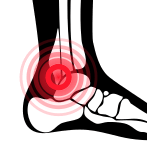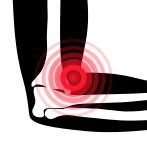More commonly referred to as “runner’s knee” or “jumper’s knee,” patellofemoral syndrome is a common overuse injury that many runners and athletes experience. But what is patellofemoral syndrome, what are its symptoms, what causes it, and how do you heal from it? For these and many other questions about Patellofemoral Syndrome, Next Level Physio has the answers.
What is Patellofemoral Syndrome?
The patella is the scientific name for the kneecap. Patellofemoral syndrome is therefore a condition that describes pain in the front of the knee and around the kneecap. The condition arises when the kneecap moves abnormally in the groove at the end of the femur (thighbone). It causes extra pressure either on the cartilage covering the kneecap or on the trochlear surface (area the femur rubs against).
What are the Causes of Patellofemoral Syndrome?
While the exact causes of patellofemoral syndrome may be hard to define, it is identified as a classic overuse injury which means any form of overuse of the knee joint could result in the condition. Because runners and other athletes who participate in high impact activities commonly experience this syndrome, it is often referred to as “runner’s knee” or “jumper’s knee.” That means runners, people who do CrossFit, or those who regularly engage in running, jumping, or squatting may be at risk for patellofemoral syndrome. Members of our Triathlon Club have suffered from this condition, and thankfully, they are all recovering well and back in the game!
Keep in mind, however, that non-athletes can also get patellofemoral syndrome. General trauma to the kneecap (i.e., falling on it or hitting it against a hard surface) could result in injury to the area.
Signs and Symptoms of Patellofemoral Syndrome
Some of the most common signs and symptoms of patellofemoral syndrome include:
- A dull, aching pain in the front of the knee (one or both knees)
- Pain ranging from general discomfort to more intense pain
- Pain when bending the knee
- Pain that is especially present when climbing stairs, jumping, or squatting
- Pain after sitting for an extended time with the knee bent (as in sitting at a movie theater)
- A cracking or popping sound in the knee when climbing stairs or after sitting for long time
How to Diagnose Patellofemoral Syndrome?
To diagnose patellofemoral syndrome, our physio team will conduct a thorough physio evaluation to rule out and figure out what’s bringing on your knee pain. They’ll ask what makes the pain feel better or worse, feel the kneecap for signs of instability, and ask the patient to engage in a series of range-of-motion exercises.
While physicians may occasionally need to order imaging tests, most cases of patellofemoral syndrome can be diagnosed without X-rays or MRIs.
Treatment for Patellofemoral Syndrome
Patellofemoral syndrome may heal from active rest, but knowing what you should and shouldn’t do while you actively rest is where our physio team can help.
Next Level Physio Physical Therapy for Patellofemoral Syndrome
Physical therapy for patellofemoral syndrome can help patients prevent the condition from arising as well as help them recover from it if it is already in progress. Our team is committed to keeping you active, happy, and healthy.
What do we do differently at Next Level? On top of using cutting edge modalities and treatment strategies, we also provide you with programming to keep the rest of your body from deteriorating, and for those who are active, we can coach you on what CAN do to keep fit and healthy during the long recovery process.
Using our MEI Method, we work closely with you to design the right plan of care for you. The frustrations we often hear from clients who have been to the mill or corporate physical therapy practices include:
- The PT there didn’t really spend a lot of time with me.
- The PT was seeing 5 other patients at the same time.
- All they did was put on a hot pack, rub some gel on my hip, then have me do pointless exercises on my own.
- They didn’t care about my goals after surgery and did nothing to get me back to my favorite activities.
Does this sound like the type of PT place that will get you the results you want?
That’s why we’re different :)
In addition to physical therapy for patellofemoral syndrome, Next Level Physio also treats many other conditions including:
- Pre-surgical rehab
- Post-surgical rehab
- Neck pain
- Shoulder and elbow pain
- Vertigo and concussion
- Wrist and hand pain
- Ankle and foot pain
- Sciatica/back pain… and more
Some of the physical therapy methods we use for pain treatment include:
- IASTM Technique
- Blood Flow Restriction Training
- Therapeutic Exercise
- Shockwave
- Cold Laser
- Australian Manual Therapy
- Cupping, and more
Click here to schedule an appointment and a free consultation.















